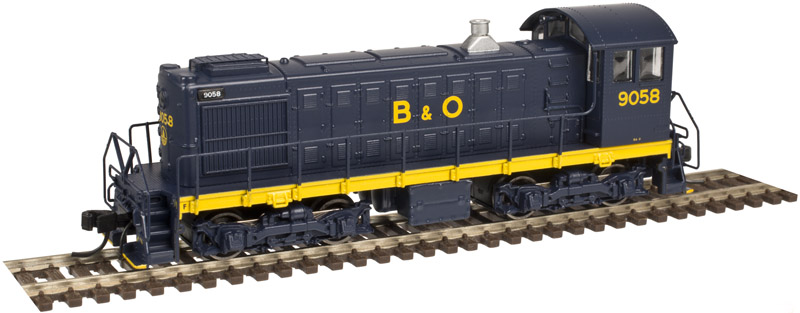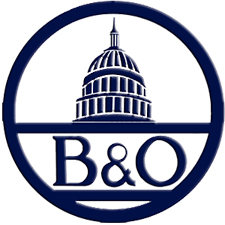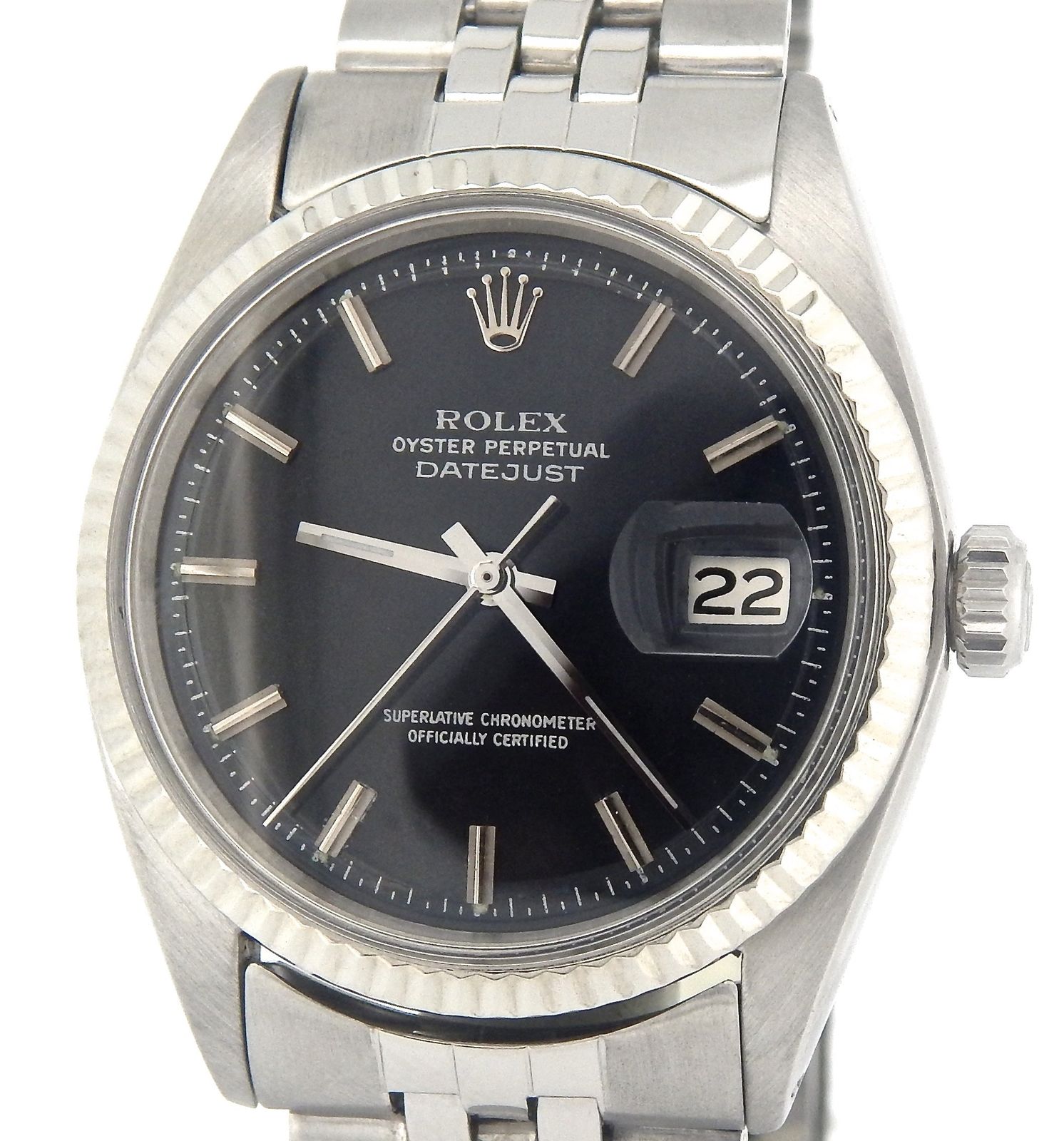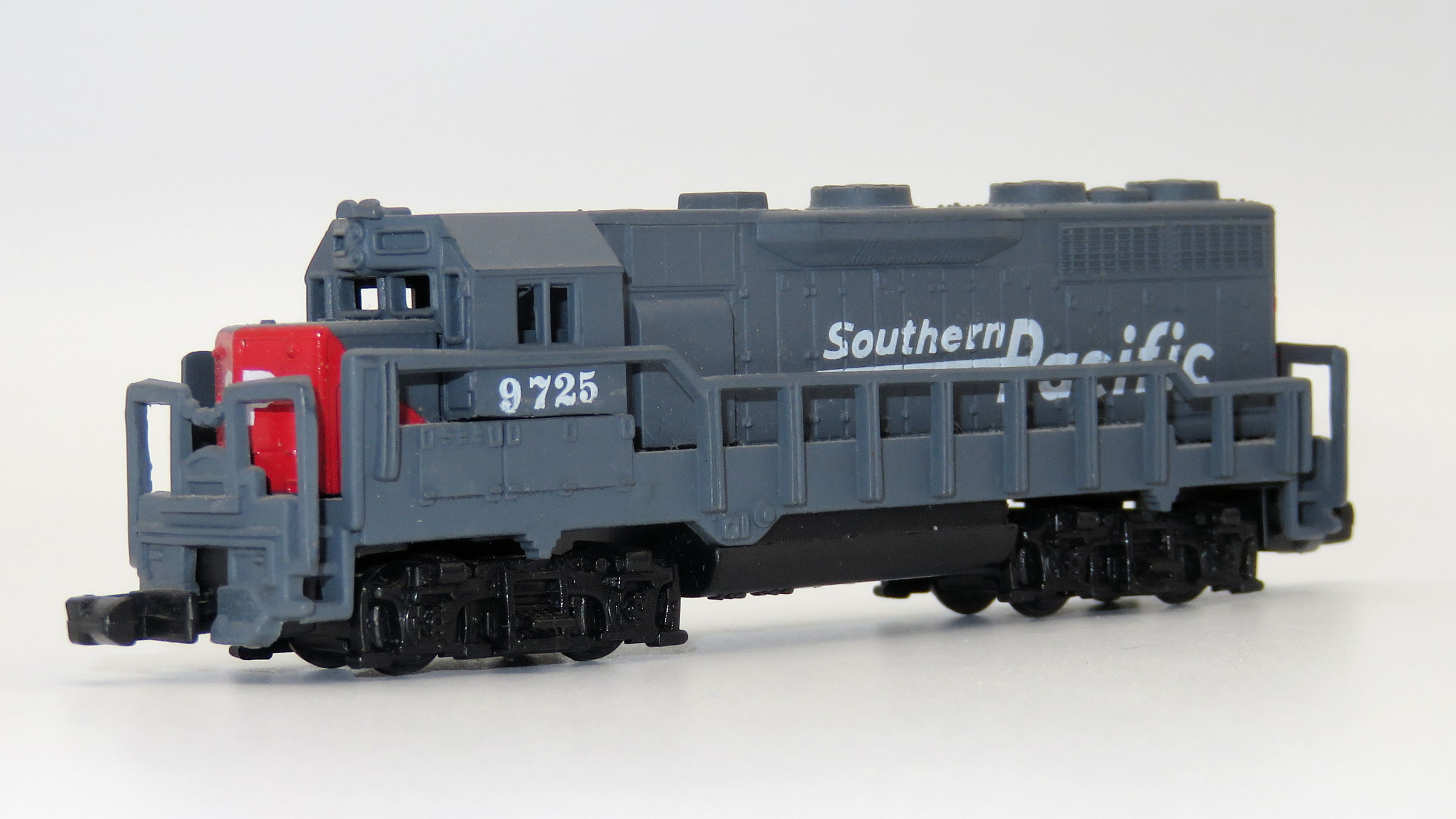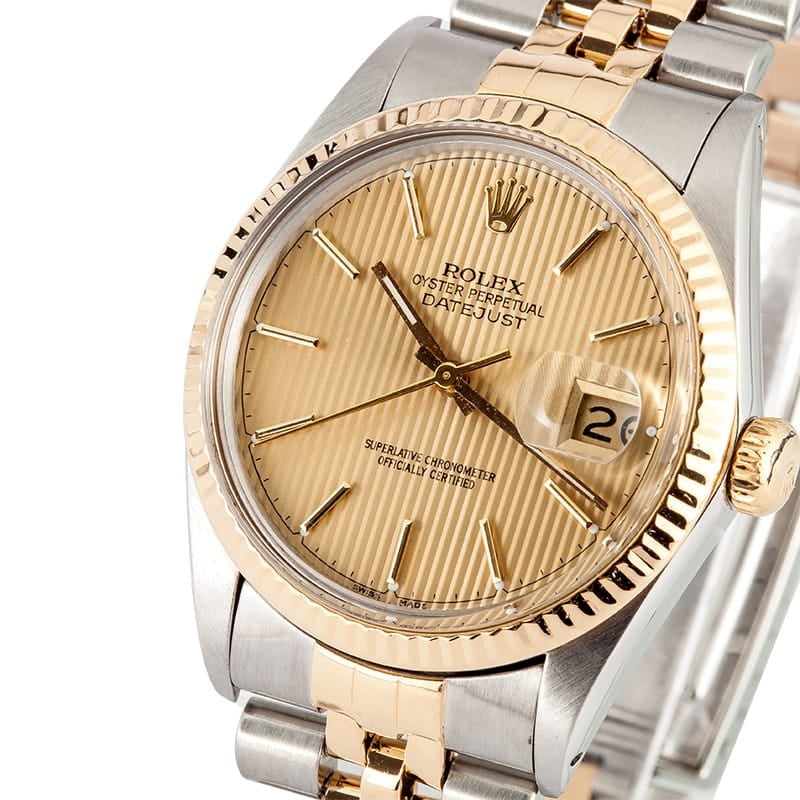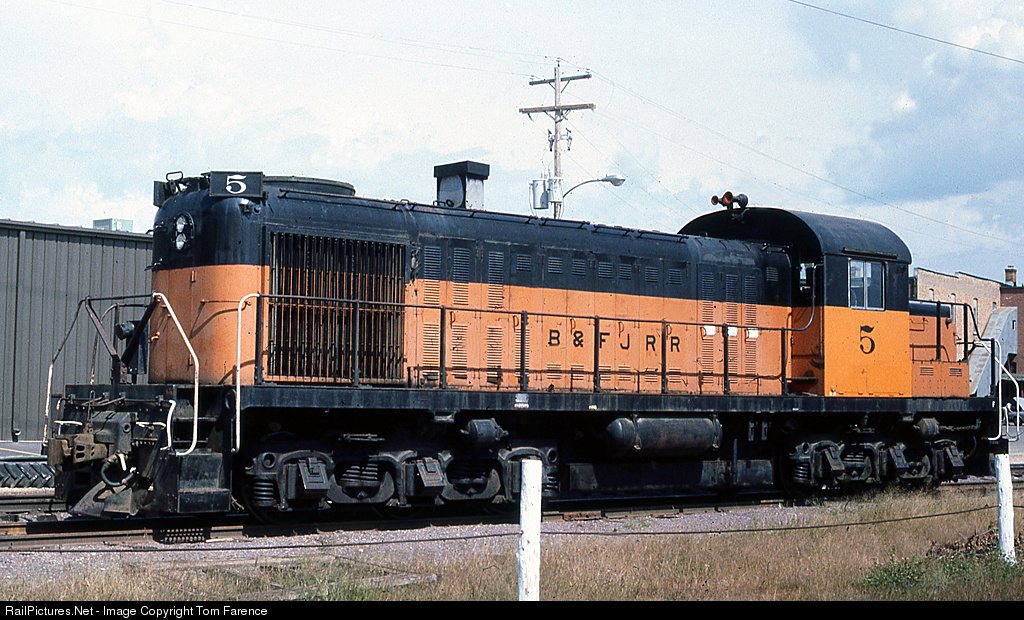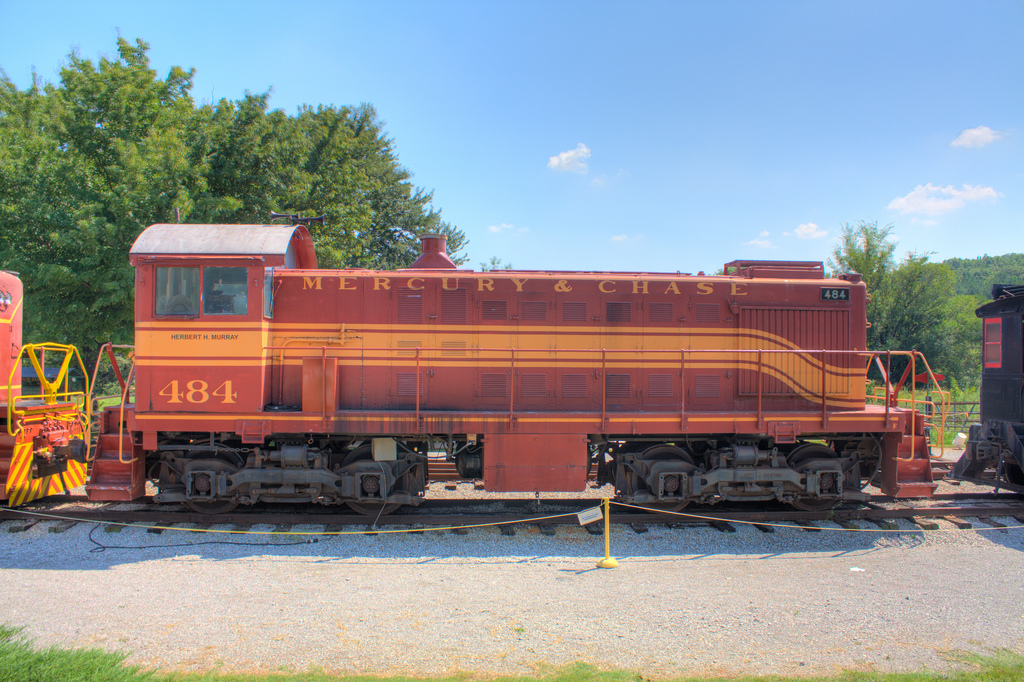Atlas - 40 002 917 - Locomotive, Diesel, Alco S-2 - Baltimore & Ohio - 9058
| Stock Number | 40 002 917 |
| Original Retail Price | $239.95 |
| Brand | Atlas |
| Manufacturer | Atlas |
| Body Style | Atlas Diesel Switcher S2 |
| Image Provider's Website | Link |
| Prototype Vehicle | Locomotive, Diesel, Alco S-2 (Details) |
| Road or Company Name | Baltimore & Ohio (Details) |
| Road or Reporting Number | 9058 |
| Paint Color(s) | Blue |
| Print Color(s) | Yellow |
| Coupler Type | AccuMate Magnetic Knuckle |
| Wheel Type | Chemically Blackened Metal |
| Wheel Profile | Small Flange (Low Profile) |
| DCC Readiness | DC/DCC Dual Mode Decoder w/Sound |
| Announcement Date | 2016-06-01 |
| Release Date | 2017-07-01 |
| Item Category | Locomotives |
| Model Type | Diesel |
| Model Subtype | Alco |
| Model Variety | S-2 |
| Prototype Region | North America |
| Prototype Era | NA Era III: Transition (1939 - 1957) |
| Scale | 1/160 |
Model Information:
This model was introduced in 2015 by Atlas. It was their first offering with integrated DCC and Sound. The engine comes in two versions, the Silver (DCC Ready) and the Gold (Decoder Installed with Sound functions).
This engine looks great but suffers from sketchy power pickup on any non-pristine tracks. This can radically affect the sound effects as they cut in and out. This is due to the limits of a lightweight, 4-axle design. The sound effects are immensely cool and once it is up to speed, it can run consistently well. I recommend removing the realistic acceleration for operation on any not-so-perfect track so that it has a chance to get going and use momentum to carry over dodgy track sections and turnouts.
This model features: Scaled from actual prototype measurements; Option for horizontal or vertical radiator shutters; Fine scale handrails; Separately-applied coupler cut levers, air hoses, piping, etc.; Directional LED lighting (includes cab rear headlight); Die-cast hood & chassis for improved pulling performance; Digital-ready chassis; Dual-flywheels for maximum performance at all speeds; Factory-equipped with AccuMate? knuckle couplers; Exceptional painting and printing
Here you can find a YouTube Video Review
This engine looks great but suffers from sketchy power pickup on any non-pristine tracks. This can radically affect the sound effects as they cut in and out. This is due to the limits of a lightweight, 4-axle design. The sound effects are immensely cool and once it is up to speed, it can run consistently well. I recommend removing the realistic acceleration for operation on any not-so-perfect track so that it has a chance to get going and use momentum to carry over dodgy track sections and turnouts.
This model features: Scaled from actual prototype measurements; Option for horizontal or vertical radiator shutters; Fine scale handrails; Separately-applied coupler cut levers, air hoses, piping, etc.; Directional LED lighting (includes cab rear headlight); Die-cast hood & chassis for improved pulling performance; Digital-ready chassis; Dual-flywheels for maximum performance at all speeds; Factory-equipped with AccuMate? knuckle couplers; Exceptional painting and printing
Here you can find a YouTube Video Review
DCC Information:
Sound Functionality Features (GOLD LOCOMOTIVES ONLY):
Over 20 sound effects are available, including engine start-up and shutdown, prime mover sounds through all eight notches, bell, air horn, air compressor, dynamic brakes and more. There are 16 user-selectable horns, 2 user-selectable bells, and 2 user-selectable synchronized brake squeals. Manual and Automatic Notching modes with the ability to change modes *on the fly* are provided for true realism.
Prototype History:
Built by the American Locomotive Company (Alco) the low-hood S-2 was introduced in 1940 to replace Alco's earlier high-hood switchers. The 1000 horsepower S-2 was a turbocharged version of the S-1. There were 1,502 S-2s sold to North American Railroads. The versatility of the S-2s was evidenced by their service on mainline, shortline and industrial railroads. This engine was run by many many roadnames which included large customers like the Santa Fe as well as smaller operations such as the Lehigh Valley
From Wikipedia
From Wikipedia
Road Name History:
The Baltimore and Ohio Railroad (reporting marks B&O, BO) is one of the oldest railroads in the United States and the first common carrier railroad. It came into being mostly because the city of Baltimore wanted to compete with the newly constructed Erie Canal (which served New York City) and another canal being proposed by Pennsylvania, which would have connected Philadelphia and Pittsburgh. At first this railroad was located entirely in the state of Maryland with an original line from the port of Baltimore west to Sandy Hook. At this point to continue westward, it had to cross into Virginia (now West Virginia) over the Potomac River, adjacent to the confluence of the Potomac and Shenandoah rivers. From there it passed through Virginia from Harpers Ferry to a point just west of the junction of Patterson Creek and the North Branch Potomac River where it crossed back into Maryland to reach Cumberland. From there it was extended to the Ohio River at Wheeling and a few years later also to Parkersburg, West Virginia.
It is now part of the CSX Transportation (CSX) network, and includes the oldest operational railroad bridge in the USA. The B&O also included the Leiper Railroad, the first permanent horse-drawn railroad in the U.S. In later years, B&O advertising carried the motto: "Linking 13 Great States with the Nation." Part of the B&O Railroad's immortality has come from being one of the four featured railroads on the U.S. version of the board game Monopoly, but it is the only railroad on the board which did not serve Atlantic City, New Jersey, directly.
When CSX established the B&O Railroad Museum as a separate entity from the corporation, some of the former B&O Mount Clare Shops in Baltimore, including the Mt. Clare roundhouse, were donated to the museum while the rest of the property was sold. The B&O Warehouse at the Camden Yards rail junction in Baltimore now dominates the view over the right-field wall at the Baltimore Orioles' current home, Oriole Park at Camden Yards.
At the end of 1970 B&O operated 5552 miles of road and 10449 miles of track, not including the Staten Island Rapid Transit (SIRT) or the Reading and its subsidiaries.
Read more on Wikipedia.
It is now part of the CSX Transportation (CSX) network, and includes the oldest operational railroad bridge in the USA. The B&O also included the Leiper Railroad, the first permanent horse-drawn railroad in the U.S. In later years, B&O advertising carried the motto: "Linking 13 Great States with the Nation." Part of the B&O Railroad's immortality has come from being one of the four featured railroads on the U.S. version of the board game Monopoly, but it is the only railroad on the board which did not serve Atlantic City, New Jersey, directly.
When CSX established the B&O Railroad Museum as a separate entity from the corporation, some of the former B&O Mount Clare Shops in Baltimore, including the Mt. Clare roundhouse, were donated to the museum while the rest of the property was sold. The B&O Warehouse at the Camden Yards rail junction in Baltimore now dominates the view over the right-field wall at the Baltimore Orioles' current home, Oriole Park at Camden Yards.
At the end of 1970 B&O operated 5552 miles of road and 10449 miles of track, not including the Staten Island Rapid Transit (SIRT) or the Reading and its subsidiaries.
Read more on Wikipedia.
Brand/Importer Information:
In 1924 Stephan Schaffan, Sr. founded the Atlas Tool Company in Newark, New Jersey. In 1933 his son, Stephan Schaffan, Jr., came to work for his father at the age of sixteen. Steve Jr. built model airplanes as a hobby and frequented a local hobby shop. Being an enterprising young man, he would often ask the owner if there was anything he could do to earn some extra spending money. Tired of listening to his requests, the hobby-store owner threw some model railroad track parts his way and said, "Here, see if you can improve on this".
In those days, railroad modelers had to assemble and build everything from scratch. Steve Jr. created a "switch kit" which sold so well, that the entire family worked on them in the basement at night, while doing business as usual in the machine shop during the day.
Subsequently, Steve Jr. engineered the stapling of rail to fiber track, along with inventing the first practical rail joiner and pre-assembled turnouts and flexible track. All of these products, and more, helped to popularize model railroading and assisted in the creation of a mass-market hobby. The budding entrepreneur quickly outgrew the limitations of a basement and small garage operation. Realizing they could actually make a living selling track and related products, Steve and his father had the first factory built in Hillside, New Jersey at 413 Florence Avenue in 1947. On September 30, 1949, the Atlas Tool Company was officially incorporated as a New Jersey company.
In 1985, Steve was honored posthumously for his inventions by the Model Railroad Industry Association and was inducted into the Model Railroad Industry Hall of Fame in Baltimore, Maryland. In addition, Steve was nominated and entered into the National Model Railroad Association Pioneers of Model Railroading in 1995.
In the early 1990s, the Atlas Tool Company changed its name to Atlas Model Railroad Company, Inc.
In those days, railroad modelers had to assemble and build everything from scratch. Steve Jr. created a "switch kit" which sold so well, that the entire family worked on them in the basement at night, while doing business as usual in the machine shop during the day.
Subsequently, Steve Jr. engineered the stapling of rail to fiber track, along with inventing the first practical rail joiner and pre-assembled turnouts and flexible track. All of these products, and more, helped to popularize model railroading and assisted in the creation of a mass-market hobby. The budding entrepreneur quickly outgrew the limitations of a basement and small garage operation. Realizing they could actually make a living selling track and related products, Steve and his father had the first factory built in Hillside, New Jersey at 413 Florence Avenue in 1947. On September 30, 1949, the Atlas Tool Company was officially incorporated as a New Jersey company.
In 1985, Steve was honored posthumously for his inventions by the Model Railroad Industry Association and was inducted into the Model Railroad Industry Hall of Fame in Baltimore, Maryland. In addition, Steve was nominated and entered into the National Model Railroad Association Pioneers of Model Railroading in 1995.
In the early 1990s, the Atlas Tool Company changed its name to Atlas Model Railroad Company, Inc.
Item created by: gdm
on 2017-07-31 13:36:54
If you see errors or missing data in this entry, please feel free to log in and edit it. Anyone with a Gmail account can log in instantly.
If you see errors or missing data in this entry, please feel free to log in and edit it. Anyone with a Gmail account can log in instantly.


